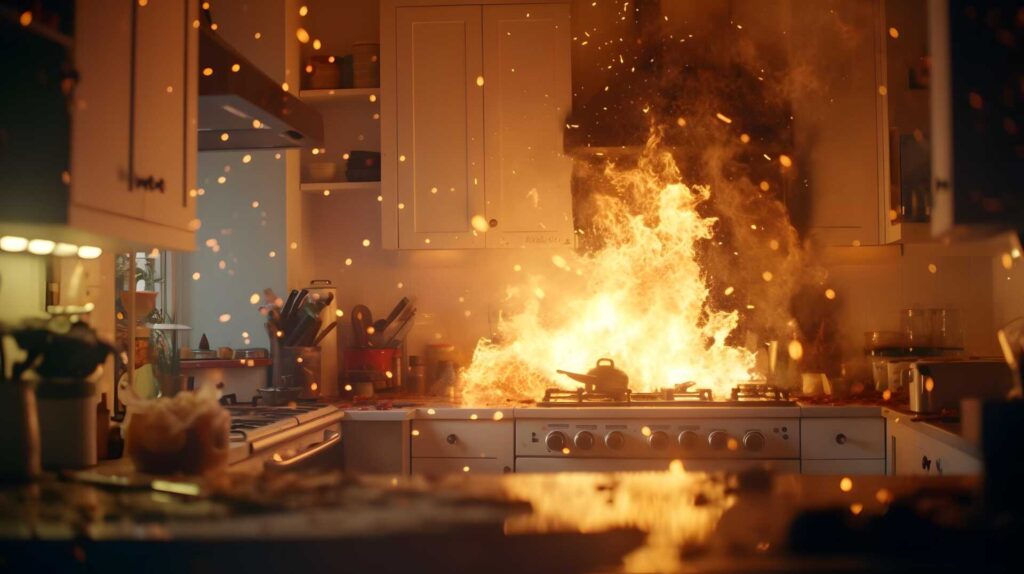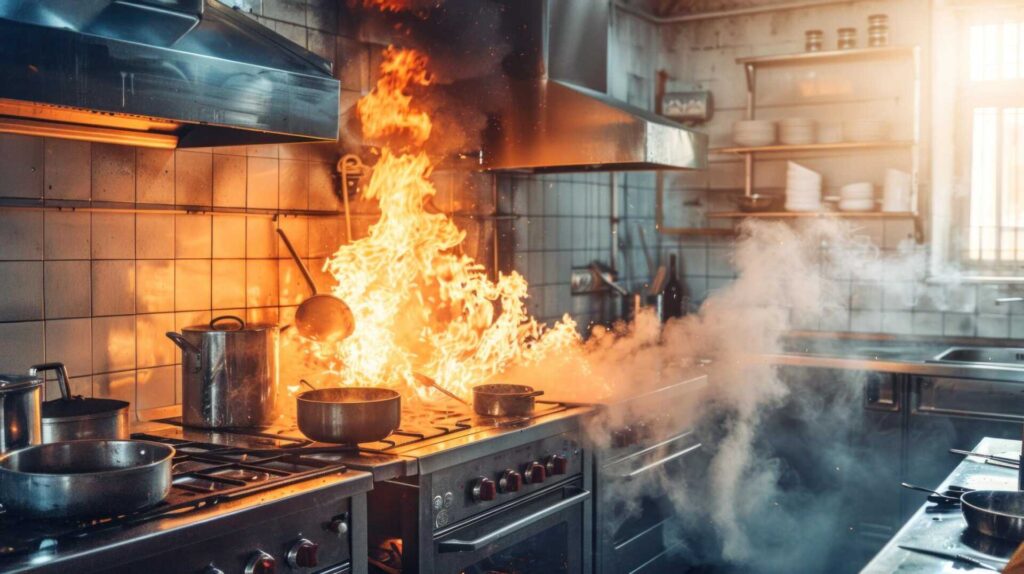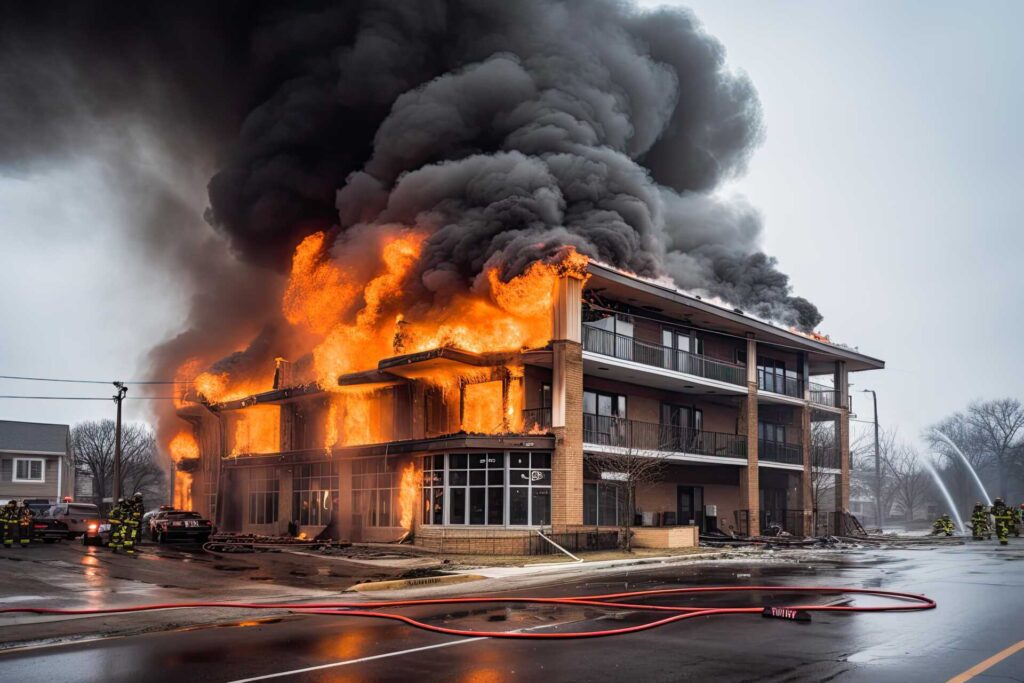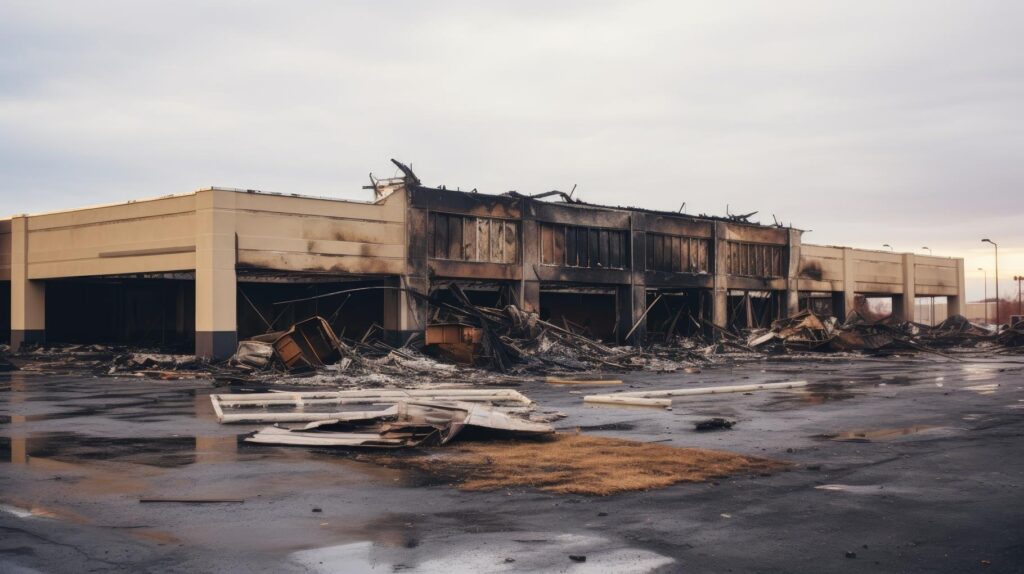
Contents
When you’re faced with the aftermath of a fire, knowing where to start can feel overwhelming. It’s crucial to focus on finding the right fire damage restoration services that prioritize safety and efficiency. Begin by assessing the extent of the damage, but don’t forget the importance of documenting everything for your insurance claim. You might be surprised at the advanced techniques available for smoke and soot removal. However, there are even more essential strategies that can significantly impact the restoration process. What are those key steps you shouldn’t overlook?
Key Takeaways
- Conduct a thorough initial assessment to document visible and hidden fire damage for effective restoration planning and insurance claims.
- Prioritize safety by wearing protective gear and avoiding structurally compromised areas during the restoration process.
- Utilize effective cleaning methods, including damp cloths and HEPA filter vacuums, to remove soot and smoke odor systematically.
- Assess water damage and promptly address any moisture issues to prevent mold growth and further deterioration of the property.
- Engage professional restoration services for expertise in comprehensive damage recovery and to streamline the insurance claims process.
Assessing Fire Damage
When it comes to assessing fire damage, you’ll want to start by walking through the affected areas with a keen eye.
Begin your fire assessment by documenting all visible damage, which includes charred structures, smoke stains, and any signs of water damage from firefighting efforts. Take notes and photographs to create a comprehensive record that you can reference later.
As you proceed, focus on evaluating the extent of the damage. Look for compromised structural elements like beams, walls, and roofs, as these can directly affect the safety and stability of the property.
Pay attention to the materials used in construction; different materials react uniquely to fire, impacting the damage evaluation process.
Don’t forget to assess hidden areas, such as behind walls or under flooring, where damage may not be immediately visible. Smoke can penetrate deeply, leaving behind soot and odors that require specialized cleaning.
Finally, consider the contents of the space. Inventory any personal belongings or furnishings that might’ve been affected.
This helps in understanding the overall impact of the fire and assists in insurance claims and restoration planning.
Ensuring Safety First
Prioritizing safety is essential after a fire, as the aftermath can pose numerous hazards. Before you even step back into your property, ensure that the area has been declared safe by emergency services. This is crucial because lingering smoke, structural damage, or hazardous materials can create dangerous situations.
When you return, follow these fire safety guidelines and emergency protocols to protect yourself and your loved ones:
| Safety Checklist | Action Steps |
|---|---|
| Personal Protective Gear | Wear gloves, masks, and goggles to shield against soot and debris. |
| Structural Integrity | Check for visible damage. If you see sagging ceilings or walls, stay out. |
| Electrical Hazards | Avoid using electricity until a professional checks the wiring. |
| Water Hazards | Be cautious of standing water, as it can lead to electrocution. |
| Smoke and Air Quality | Ventilate the space carefully to improve air quality before re-entering. |
Documenting the Damage
When documenting fire damage, taking detailed photographs is essential for an accurate record of your losses.
You’ll also want to compile a comprehensive inventory of all affected items, noting their condition and value.
This thorough documentation can significantly aid in your insurance claims process and restoration efforts.
Take Detailed Photographs
Documenting the damage caused by fire is crucial for both insurance claims and the restoration process. Taking detailed photographs provides essential photographic evidence that can substantiate your claims and guide the restoration documentation.
When capturing images, keep these tips in mind:
Focus on the Extent of Damage: Take wide shots to show overall damage and close-ups to highlight specific areas of concern.
Document All Affected Areas: Don’t forget to photograph hidden spaces like attics, basements, and behind walls, as these can reveal underlying issues.
Capture Personal Belongings: Document damaged items, especially those of sentimental value, as this can impact your claim and assist in the restoration process.
Consider Time Stamps: If possible, use a camera that adds date and time information to your photos, providing a timeline of the damage.
Compile Comprehensive Inventory
A comprehensive inventory is essential for effectively managing the aftermath of fire damage. By compiling an accurate inventory checklist, you can document all affected items, which is crucial for insurance claims and restoration processes.
Start by walking through your property and noting everything that’s damaged or destroyed. This includes furniture, appliances, and personal belongings.
As you create your inventory, assign an inventory valuation to each item. This will help you understand the financial impact of the loss and ensure you receive proper compensation from your insurance provider.
Be as detailed as possible; include descriptions, purchase dates, and estimated values.
Don’t forget to categorize items by room or type for easier reference. You might even consider using digital tools or apps to streamline the process and ensure nothing is overlooked.
Having a well-organized inventory aids in insurance claims and helps you feel more in control during a chaotic time.
Water Damage Considerations
After a fire, assessing water damage is crucial to understand the extent of the problem and prevent further complications.
You’ll need to implement effective drying and restoration techniques to mitigate long-term effects.
Addressing these factors promptly can significantly enhance the overall recovery process.
Assessing Water Damage
When assessing water damage, it’s crucial to act swiftly and thoroughly to minimize further complications. The first step is water source identification. Understanding where the water came from helps you determine the extent of the damage and the appropriate response.
Next, conduct a moisture assessment to evaluate how deeply the water has penetrated various materials in your space.
Here are some key considerations to keep in mind:
Check for visible signs: Look for discoloration, peeling paint, or warping in walls and floors.
Inspect hidden areas: Don’t forget to examine behind appliances and under carpets, as water can often hide in these spaces.
Use moisture meters: These tools can help you measure moisture levels in walls and other structures accurately.
Document everything: Take photos and notes to keep a detailed record of the damage for insurance purposes.
Drying and Restoration Techniques
Effective drying and restoration techniques are essential to prevent long-term damage following water exposure. When you’re faced with water damage, it’s crucial to act quickly. Start by assessing the extent of the damage, and then choose appropriate drying methods to mitigate further issues like mold growth.
Air movers and dehumidifiers are your best friends in this process. They help circulate air and remove moisture effectively, ensuring your space dries out properly.
Consider using specialized restoration equipment, such as infrared cameras, to identify hidden moisture pockets in walls and floors. This ensures that no area is overlooked during the drying process.
Don’t forget about your belongings; items like carpets, furniture, and personal effects may require specific drying methods to avoid permanent damage.
Once everything is dried, restoration can begin. This might involve replacing damaged materials or cleaning surfaces to restore your property to its pre-loss condition.
Smoke and Soot Removal
Smoke and soot removal is often one of the most challenging aspects of fire damage restoration. The lingering smoke odor and soot staining can be pervasive, affecting surfaces and the air quality within your home.
To effectively tackle these challenges, you need a systematic approach to ensure a thorough cleanup.
Here are some essential tips for effective smoke and soot removal:
Assess the Damage: Start by evaluating the extent of the soot staining and smoke odor. Identify affected areas to prioritize your cleaning efforts.
Use Proper Equipment: Invest in high-quality vacuum cleaners with HEPA filters and specialized cleaning solutions designed for smoke and soot removal.
Clean Surfaces Methodically: Use a damp cloth to wipe down walls, ceilings, and furniture. For tougher soot stains, a sponge, a mixture of water, and a mild detergent can be effective.
Ventilate the Area: Open windows and use fans to help expel smoke odor and improve air circulation. Consider using air purifiers equipped with activated carbon filters for better odor removal.
Structural Integrity Evaluation
After a fire, your home’s structural integrity might be compromised, making it crucial to assess any damage thoroughly. You need to focus on the structural stability of your property to ensure it’s safe for you and your loved ones.
Start by inspecting visible signs of damage, such as cracks in walls, sagging ceilings, or warped floors. These indicators are often the first clues that your home may require extensive repairs.
Engaging a professional for a comprehensive damage assessment is wise. They possess the expertise to identify hidden issues that may not be immediately apparent.
Structural engineers or certified restoration experts will evaluate load-bearing walls, the foundation, and other critical components of your home. They’ll assess whether the fire weakened vital structural elements and recommend necessary repairs or reinforcements.
Don’t overlook the importance of this evaluation. Ignoring potential structural damage could lead to further complications down the line, including safety hazards or increased repair costs.
Make sure you document all findings, as this information can be invaluable when dealing with insurance claims or future renovations.
The goal is to restore your home to a safe and livable condition. Once you’ve completed the damage assessment and addressed any structural concerns, you can move forward with confidence.
Effective Cleanup Techniques
Start the cleanup process as soon as it’s safe to do so, as prompt action can significantly reduce the extent of damage caused by soot, ash, and water.
To ensure you’re doing this effectively, it’s crucial to have the right cleanup equipment and to follow safety protocols, especially when dealing with hazardous materials that may have been released during the fire.
Here are some key techniques to implement during your cleanup:
Assess the Damage: Before diving in, take a moment to evaluate the affected areas. Identify hazardous materials like burnt wiring or chemicals that may pose risks.
Wear Protective Gear: Don’t skip on personal protective equipment (PPE). Wear gloves, masks, and goggles to safeguard yourself against harmful substances.
Use Proper Cleanup Equipment: Equip yourself with industrial-grade vacuums, air scrubbers, and moisture meters. These tools will help you effectively remove soot and ash while ensuring air quality.
Dispose of Hazardous Materials: Follow local regulations for disposing of any hazardous waste. Ensure that you’re not inadvertently spreading contaminants in the process.
Mold Prevention Strategies
To effectively prevent mold growth after fire damage, you’ll need to focus on moisture control, proper ventilation, and regular inspections.
Keeping humidity levels in check and ensuring air circulation can significantly reduce mold risk.
Moisture Control Techniques
Controlling moisture is crucial in preventing mold growth after fire damage restoration. Excess moisture can lead to a breeding ground for mold, jeopardizing your health and the integrity of your property.
To effectively manage moisture, you’ll want to employ several key techniques:
Use moisture detection tools: Invest in a reliable moisture meter to identify damp areas in your home.
Implement humidity control: Keep indoor humidity levels between 30-60% using dehumidifiers or air conditioning units.
Regularly inspect for leaks: Check plumbing and roofs for leaks that could introduce unwanted moisture.
Dry wet materials promptly: Remove and dry any water-damaged materials within 24-48 hours to prevent mold growth.
Proper Ventilation Importance
Proper ventilation plays a vital role in maintaining a healthy indoor environment, especially after fire damage restoration. When you prioritize proper air circulation, you significantly reduce the risk of mold growth, which can thrive in damp, stagnant air.
Effective ventilation systems help to expel moisture and provide a continuous flow of fresh air, creating an inhospitable environment for mold spores.
After a fire, it’s essential to open windows and doors whenever possible to enhance natural ventilation. Additionally, consider using fans to promote air movement throughout the affected areas. This approach aids in drying out surfaces and helps to eliminate residual odors and improve overall air quality.
If the damage is extensive, you might want to consult professionals who can assess and install appropriate ventilation systems tailored to your space.
These systems can include exhaust fans, dehumidifiers, or air purifiers, all designed to maintain optimal air circulation and humidity levels.
Regular Inspection Practices
Once you’ve established proper ventilation, regular inspections become a key component in preventing mold growth after fire damage.
By conducting routine checks, you can identify and address issues before they escalate, ensuring your space remains safe and healthy.
Establishing a systematic inspection schedule will aid in damage prevention and foster a sense of community among those involved in the restoration process.
Here are some essential inspection practices to implement:
Check for Moisture: Regularly inspect areas prone to moisture accumulation, such as basements and crawl spaces.
Look for Discoloration: Examine walls, ceilings, and floors for any signs of discoloration or water stains, which may indicate hidden mold.
Inspect HVAC Systems: Ensure heating and cooling systems are functioning correctly and are free from mold growth, which can spread spores throughout your space.
Assess Insulation: Examine insulation materials for dampness or damage, as these can be breeding grounds for mold.
Insurance Claims Process
Navigating the insurance claims process after experiencing fire damage can feel overwhelming, but understanding the steps involved can significantly ease the burden.
First, review your insurance policy to confirm your insurance coverage. Knowing what’s included will help you set realistic expectations as you proceed.
Next, start gathering claim documentation. This includes photos of the damage, receipts for repairs or temporary accommodations, and any relevant communication with your insurer.
Thorough documentation strengthens your claim and speeds up the processing time.
Once you’ve compiled your evidence, contact your insurance company to initiate the claim. They’ll assign an adjuster to assess the damage and determine the compensation amount.
It’s important to be prepared for this visit; make sure you’re present to explain the extent of the damage and provide any additional documentation they may require.
After the adjuster’s assessment, you’ll receive a settlement offer. Don’t hesitate to negotiate if you believe the offer doesn’t reflect the damage accurately or if it falls short of your needs.
Remember, it’s your right to seek a fair settlement that aligns with your loss.
Finally, keep communication lines open with your insurer throughout the process. Regular follow-ups can help ensure your claim progresses smoothly.
Professional Restoration Services
After a fire, enlisting professional restoration services can be crucial in your recovery journey. Fire damage isn’t just about visible destruction; it often involves hidden issues like smoke damage and structural integrity concerns.
By hiring experienced professionals, you’ll ensure a comprehensive approach to fire restoration that addresses both immediate needs and long-term safety.
Here’s what you can expect from professional restoration services:
Assessment and Inspection: Experts will perform a thorough evaluation of your property, identifying damage areas that may not be immediately visible.
Smoke and Odor Removal: Professional teams utilize specialized equipment and techniques to eliminate smoke residue and lingering odors, creating a healthier environment.
Structural Repairs and Reconstruction: From repairing walls to restoring roofs, these services will ensure your home is safe and sound.
Insurance Coordination: Many restoration companies work directly with your insurance provider, easing the claims process and helping you navigate financial challenges.
Choosing professional services speeds up the recovery process and brings peace of mind.
You’ll have knowledgeable experts guiding you through each step, ensuring that your home is restored to a safe and livable condition.
Recap
In the aftermath of a fire, transforming your space back to its former glory can feel daunting. By following these essential tips and enlisting the help of skilled professionals, you can navigate the restoration process with confidence and care. Remember, each step you take restores your home and nurtures the spirit of resilience within you. Embrace the journey ahead, knowing that brighter days are on the horizon and your home will rise anew from the ashes.



